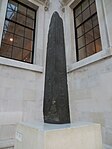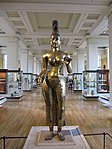Queen Elizabeth II Great Court
2000 establishments in England2000 in London2000 in the United KingdomBritish MuseumBuildings and structures in the London Borough of Camden ... and 6 more
Foster and Partners buildingsLattice shell structuresNeo-futurism architectureRedevelopment projects in LondonTourist attractions in the London Borough of CamdenUse British English from March 2014

The Queen Elizabeth II Great Court, commonly referred to simply as the Great Court, is the covered central quadrangle of the British Museum in London. It was redeveloped during the late 1990s to a design by Foster and Partners, from a 1970s design by Colin St John Wilson. The court was opened by Queen Elizabeth II in 2000.
Excerpt from the Wikipedia article Queen Elizabeth II Great Court (License: CC BY-SA 3.0, Authors, Images).Queen Elizabeth II Great Court
Great Court, London Bloomsbury (London Borough of Camden)
Geographical coordinates (GPS) Address Nearby Places Show on map
Geographical coordinates (GPS)
| Latitude | Longitude |
|---|---|
| N 51.519444444444 ° | E -0.12694444444444 ° |
Address
Reading Room
Great Court
WC1B 3DE London, Bloomsbury (London Borough of Camden)
England, United Kingdom
Open on Google Maps









